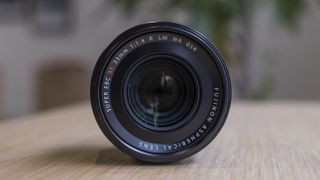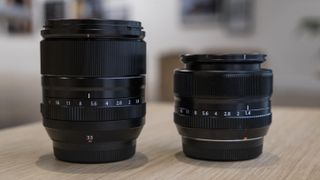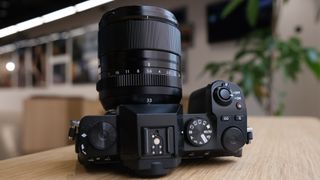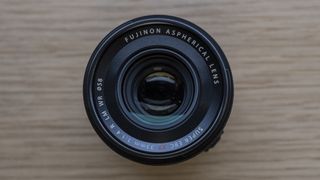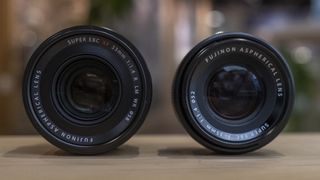The ‘nifty fifty’ lens has been considered a camera bag essential since the early days of film – and the new Fujifilm XF33mm f/1.4 R LM WR is aiming to be another classic example of this popular, versatile focal length.
Because it’s designed for the crop sensors of Fujifilm X-series cameras, this lens offers a 50mm equivalent focal length in full-frame terms. And that field of view makes it ideal for everything from portraits to street photography and even landscapes.
Fujifilm is keen to stress that the XF33mm f/1.4 R LM WR isn’t a ‘Mark II’ version of the legendary XF35mm f/1.4 R lens, despite the similarities in focal length and price. Instead, it’s an alternative option for those who want with a trusty 50mm companion with modern bells and whistles, like weather-proofing and linear autofocus motors.
So is the XF33mm f/1.4 R LM WR shaping up to be another essential lens for fans of Fujifilm X-series cameras? We took a pre-production sample out for a brief one-hour stroll around London to find out.
Fujifilm XF33mm f/1.4 R LM WR price and release date
The Fujifilm XF33mm f/1.4 prime lens will be available to buy from late September for $799 / £699. This makes it a little pricier than the classic Fujifilm XF 35mm f/1.4 R Lens, but not my much – despite being nine years old, that lens still retails for $599 / £499 / AU$775.
Perhaps the XF33mm f/1.4’s bigger rival will be the Viltrox AF 33mm f1.4 STM, a more budget X-mount alternative that arrived last year for $279 / £269 / AU$419. While it lacks weather-proofing or a linear AF motor, it could still be worth considering if you don’t want to splash out on the more premium XF33mm f/1.4.
Fujifilm XF33mm f/1.4 R LM WR design
As soon as you pick up the XF33mm f/1.4 R LM WR it’s immediately clear that this isn’t a ‘Mark II’ version of the Fujifilm XF 35mm f/1.4 R. Despite their similar focal lengths, they’re different lenses with very different characters.
The XF33mm f/1.4 R LM WR is very similar in size and build to the recent XF18mm f/1.4 R LM WR, which isn’t too surprising – that lens also has 15 elements arranged in nine groups, along with linear autofocus motors (hence the ‘LM’ in the name).
At 360g, the two lenses weigh almost exactly the same, too. This is pretty light for an f/1.4 lens, particularly compared to 50mm full-frame equivalents. And it balanced very nicely with the Fujifilm X-T3 we tried it with.
On the other hand, this does mean the XF33mm f/1.4 does weigh twice as much as the impossibly-light Fujifilm XF35mm f/1.4 R and XF35mm f/2.0 – and there’s a chance it’ll be a tad front-heavy when paired with Fujifilm’s smaller X-series cameras. We suspect it’ll be fine, if not quite the natural ‘soul mate’ for an X-T30 MK II that those other two lenses might be.
Otherwise, the XF33mm f/1.4 feels incredibly well built and has a rugged dust- and moisture-resistant design. As is customary on Fujifilm lenses, you get a clicking aperture ring, which makes it easy to tweak your exposure while looking through a viewfinder. There’s also an aperture lock, to prevent accidental knocks to your settings, and a smooth focus ring for manual control.
All in all, the XF33mm f/1.4 is a lovely, polished lens that fits nicely into the Fujifilm system, even if some may have wished to see it cram all that tech into a design that’s closer in size to the old XF35mm f/1.4.
Fujifilm XF33mm f/1.4 R LM WR performance
One of the most important additions to the Fujifilm XF33mm f/1.4 R LM WR is that linear autofocus motor, which is becoming a standard feature on new Fujifilm prime lenses.
The main benefits of this are autofocus speed and also how quiet the lens is when focusing. One of the ‘charms’ of the old XF35mm f/1.4’s is that it sounds about as subtle as a transforming Optimus Prime when locking onto a subject – not so with the XF33mm f/1.4 R LM WR.
In our short time with it, the XF33mm f/1.4 was near-silent when focusing, without much ‘focus breathing’ (the small change in focal length when focus is adjusted). This makes it ideal for street photographers, particularly when using a silent electronic shutter, and also video shooters.
Like the XF35mm f/2.0, it also has a decent close-focusing distance of 30cm, which means you can get relatively close to subjects for detail shots, while throwing the background completely out of focus when shooting wide open.
Of course, one of the big reasons for buying an f/1.4 lens is to get the smooth, creamy bokeh that’s traditionally a bit more attainable on full-frame cameras. And in our very brief time with a pre-production XF33mm f/1.4, it certainly seems to deliver here.
The lens’ nine aperture blades mean that highlights look pleasingly round when shooting at f/1.4, even if they can take on a slight cat’s-eye shape towards the corners. And center sharpness certainly looks impressive so far, too.
One of the most interesting things about the XF33mm f/1.4 is that Fujifilm has said it “has been designed to support camera sensors of even greater resolution to be developed in the future”. This not only confirms that Fujifilm is developing higher-resolution cameras like the rumored Fujifilm X-H2, but that they could squeeze even more performance out of it.
Until those cameras arrive, we’ll have to base our XF33mm f/1.4 verdict on how it performs with today’s crop of Fuji cameras. So far, it looks very promising, but we’ll update this preview with more samples and thoughts when we’ve been able to take it out for longer than an hour.
Fujifilm XF33mm f/1.4 R LM WR early thoughts
It’s too early for definitive statements on the finer points of the XF33m f/1.4 R LM WR’s performance, particularly as we were only using a pre-production version of the lens. But we did managed to get a glimpse of this lens’ character – and that’s one that’s very different from the much-revered XF35mm f/1.4.
Like the recent XF18mm f/1.4 R LM WR, this is a very modern lens that prioritizes fast, silent autofocus and sharpness over the imperfections (deliberate or not) of its older, and some would say dated, XF35mm cousin. The XF33mm f/1.4 R LM will pair very nicely with cameras like the Fujifilm X-T4 and Fujifilm X-S10, but perhaps less so with smaller bodies like the new Fujifilm X-T30 II.
It’s shaping up to be another fine option for portrait and street photographers who want a ‘nifty fifty’ with pleasing bokeh and low-light performance, but without the full-frame price tag. But to see the absolute best of what it can do, we might have to wait for those higher-resolution cameras that Fujifilm has tantalizingly hinted at during the XF33mm f/1.4’s release.


